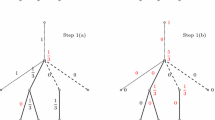Abstract
We introduce a new type of adversary for online graph problems thus allowing parametrized analysis of online algorithms with respect to a natural parameter. The new adversary is parameterized by a single integer \(\kappa \), which upper bounds the number of connected components that the adversary can use at any time during the presentation of the online graph G. We call this adversary “\(\kappa \)-components-bounded”, or \(\kappa \)-CB for short. On one hand, this adversary is restricted compared to the classical adversary because of the \(\kappa \)-CB constraint. On the other hand, we seek competitive ratios parameterized only by \(\kappa \) with no dependence on the input length n, thereby giving the new adversary power to use arbitrarily large inputs. We study online coloring under the \(\kappa \)-CB adversary. We obtain a finer analysis of the existing algorithms FirstFit and CBIP by computing their competitive ratios on trees and bipartite graphs under the new adversary: (1) Perhaps surprisingly, FirstFit outperforms CBIP on trees; (2) The competitive ratio of CBIP on bipartite graphs is simply \(\kappa \). We also study several well known classes of graphs, such as 3-colorable, \(C_k\)-free, d-inductive, planar, and bounded treewidth, with respect to online coloring under the \(\kappa \)-CB adversary. We demonstrate that the extra adversarial power of unbounded input length outweighs the restriction on the number of connected components leading to non-existence of competitive algorithms for these classes.





Similar content being viewed by others
Notes
Some examples of “online-like” models of computation are dynamic graph algorithms, temporal graph algorithms, streaming graph algorithms, priority graph algorithms, and so on.
We will always use n to refer to |V| and m to refer to |E|.
Notation [n] stands for \(\{1, 2, \ldots , n\}\). More generally, notation [k, n] stands for \(\{k, k+1, \ldots , n\}\).
What is called by “colors” in [6], as in many other works, is what we call bins.
Note that the index of \(B_{i+1}'\) is off by one with respect to the index of layer \(L_i\) with which it is associated. This happens for \(i \ge 2\) since layer \(L_1\) has two sets \(B_1'\) and \(B_2'\) associated with it.
References
Albers, S., Schraink, S.: Tight bounds for online coloring of basic graph classes. Algorithmica pp. 1–24 (2020)
Barabási, A.L., Albert, R.: Emergence of scaling in random networks. Science 286(5439), 509–512 (1999). https://doi.org/10.1126/science.286.5439.509. https://science.sciencemag.org/content/286/5439/509
Bean, D.R.: Effective coloration. J. Symb. Log. 41(2), 469–480 (1976)
Bianchi, M.P., Böckenhauer, H.J., Hromkovič, J., Keller, L.: Online coloring of bipartite graphs with and without advice. Algorithmica 70(1), 92–111 (2014)
Bodlaender, H.L.: A partial k-arboretum of graphs with bounded treewidth. Theoretical Computer Science 209(1), 1–45 (1998). https://doi.org/10.1016/S0304-3975(97)00228-4. http://www.sciencedirect.com/science/article/pii/S0304397597002284
Gutowski, G., Kozik, J., Micek, P., Zhu, X.: Lower bounds for on-line graph colorings. In: International Symposium on Algorithms and Computation, pp. 507–515. Springer, New York (2014)
Gyárfás, A., Lehel, J.: On-line and first fit colorings of graphs. J. Graph Theory 12(2), 217–227 (1988)
Halldórsson, M.M., Szegedy, M.: Lower bounds for on-line graph coloring. Theoret. Comput. Sci. 130(1), 163–174 (1994)
Kierstead, H.A.: Coloring graphs on-line. In: Fiat, A., Woeginger, G. J. (eds.) Online Algorithms, pp. 281–305. Springer, New York (1998)
Kierstead, H.A.: On-line coloring k-colorable graphs. Israel J. Math. 105(1), 93–104 (1998)
Lovász, L., Saks, M., Trotter, W.T.: An on-line graph coloring algorithm with sublinear performance ratio. Discret. Math. 75(1–3), 319–325 (1989)
Newman, M.: Networks: An Introduction. Oxford University Press Inc, Oxford (2010)
Steffen, B.C.: Advice complexity of online graph problems. ETH Zurich, Zurich (2014)
Vishwanathan, S.: Randomized online graph coloring. J. Algorithms 13(4), 657–669 (1992)
Author information
Authors and Affiliations
Corresponding author
Additional information
Publisher's Note
Springer Nature remains neutral with regard to jurisdictional claims in published maps and institutional affiliations.
A preliminary version of the paper has appeared in the Workshop on Approximation and Online Algorithms 2020 (WAOA’20).
Y.L. acknowledges postdoctoral support via NSERC discovery grant RGPIN-04500, under which part of this work was done at Université de Montréal.
D.P. is supported by Natural Sciences and Engineering Research Council of Canada (NSERC)
Rights and permissions
About this article
Cite this article
Li, Y., Narayan, V.V. & Pankratov, D. Online Coloring and a New Type of Adversary for Online Graph Problems. Algorithmica 84, 1232–1251 (2022). https://doi.org/10.1007/s00453-021-00920-w
Received:
Accepted:
Published:
Issue Date:
DOI: https://doi.org/10.1007/s00453-021-00920-w




